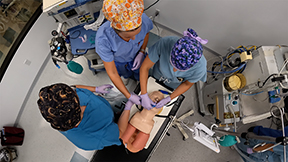Nurse anesthesia operating room simulation lab offers opportunities for UA graduate students
 Thanks to the generosity of University of Akron (UA) donors, the University’s nurse anesthesia program, Ohio’s largest in the state and one of the best in the nation, now offers its doctoral-level anesthesia students access to cutting-edge technology in a dynamic, real-world environment.
Thanks to the generosity of University of Akron (UA) donors, the University’s nurse anesthesia program, Ohio’s largest in the state and one of the best in the nation, now offers its doctoral-level anesthesia students access to cutting-edge technology in a dynamic, real-world environment.
A space in Mary Gladwin Hall, home of the UA School of Nursing, has been renovated to give nurse anesthesiology students opportunities to refine their skills using state-of-the-art equipment in a flexible setting, with regular access for hands-on practice.
UA celebrated the space with a ribbon-cutting on Wednesday, Sept. 18. The renovations were made possible in part by a donation from The University of Akron Foundation’s Stewardship & Women in Philanthropy Committee. Each year, Women in Philanthropy donors select one project to support with a goal of around $100,000 in funding.
"We are very grateful to all of the donors to this project, because the need for the anesthesia professionals is tremendous," said Dr. Brian Radesic, the UA's nurse anesthesiology track director. "UA supplies a good number of doctoral-level nurse anesthesiologists in Ohio, so it is essential for us to prepare graduates to provide good care to the citizens of the state."
The surgery simulation room was transformed from a former storage space in UA's Mary Gladwin Hall, home to the School of Nursing. The renovation included new walls, ceilings, lighting, an operating room sink, and additional electrical outlets. A one-way mirror was installed to allow simulation observation. The lab is also equipped with a large oil-less compressor, enabling the anesthesia machines to operate without needing expensive oxygen tanks. Students can use the anesthesia machines as needed for practice and understanding.
The surgical simulation room’s most significant addition is a video laryngoscope, which is a medical device with a camera used during intubation. This device affords anesthesiologists a clear view while inserting a breathing tube, making it more accurate and easier to use than a traditional laryngoscope. The device’s name is GlideScope.
Although the room was outfitted intentionally for the nurse anesthesia program, other UA nursing programs are using the space.
"We wanted an operating room set up for anesthesia students to fully simulate what it's like to do anesthesia," Radesic said. "It's also a space that anesthesia students have access to at any time. Now that we have something that looks like an operating room, our program will be even stronger."
UA's nurse anesthesia program is a post-Bachelor of Science in Nursing to a Doctor of Nursing Practice (DNP) pathway in the College of Health and Human Sciences. The three-year program prepares Bachelor of Science Intensive Care Registered Nurses to become Certified Registered Nurse Anesthetists (CRNA). Successful completion of the program leads to a DNP degree.
The University has 53 clinical sites throughout Ohio, the most of any similar program in the state. Graduates of UA's program who go on to take the CRNA national certification exam have a 99% pass rate, compared to the national average of 83%. The program has had no attrition in the past nine years. There are 114 doctoral-prepared anesthesia students in the program, the most extensive doctoral program at the University.
The University's nurse anesthesia program was established in 1992. Since its inception, the program has produced more anesthesia professionals than any other anesthesia program in Ohio, with many graduates remaining in the state to provide safe and effective anesthesia care to its citizens.
